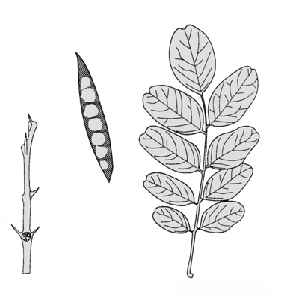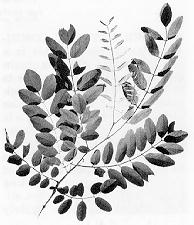Robinia pseudoacacia
 Leaves are alternate, compound, with thorns or spines.
Leaves are alternate, compound, with thorns or spines.
 The black locust's
natural range extends from Pennsylvania southwestward to Alabama and westward to southern Illinois.
The tree often suffers extensive damage from the locust borer insect.
The black locust's
natural range extends from Pennsylvania southwestward to Alabama and westward to southern Illinois.
The tree often suffers extensive damage from the locust borer insect.
The leaves are pinnately compound with 11 to 15 leaflets 1 to 1-1/2 inches long, rounded at both ends and with smooth margins.
The twigs are crooked and angular with short, stout, single, unbranched thorns, one-half inch long.
 The fruit is a
dark, red-brown, flexible pod 3 to 4 inches long, containing small, reddish brown beanlike
seeds.
The fruit is a
dark, red-brown, flexible pod 3 to 4 inches long, containing small, reddish brown beanlike
seeds.
 On young branches the bark is smooth and greenish to brown in color. On older branches and
trunks it is broken into a network of coarse, deep ridges and is gray to gray-brown in color.
On young branches the bark is smooth and greenish to brown in color. On older branches and
trunks it is broken into a network of coarse, deep ridges and is gray to gray-brown in color.
Leaves: pinnately compound; margin entire
Branching: alternate
Bark: mature trees reddish brown to nearly black, deeply furrowed. Bark is poisonous; cattle die from browsing on bark and children become ill from chewing on twigs or bark.
Height: 70 to 80 ft.
Trunk Diameter: 2 to 3 ft.
Longevity: 60 to 80 yrs.
Tolerance: intolerant
Range: east of Rocky Mountains
Fun Facts:
- Wood is resistant to rot and used to make railroad ties and fence posts.
- Fruit, pod (legume) eaten by wildlife.
![]()